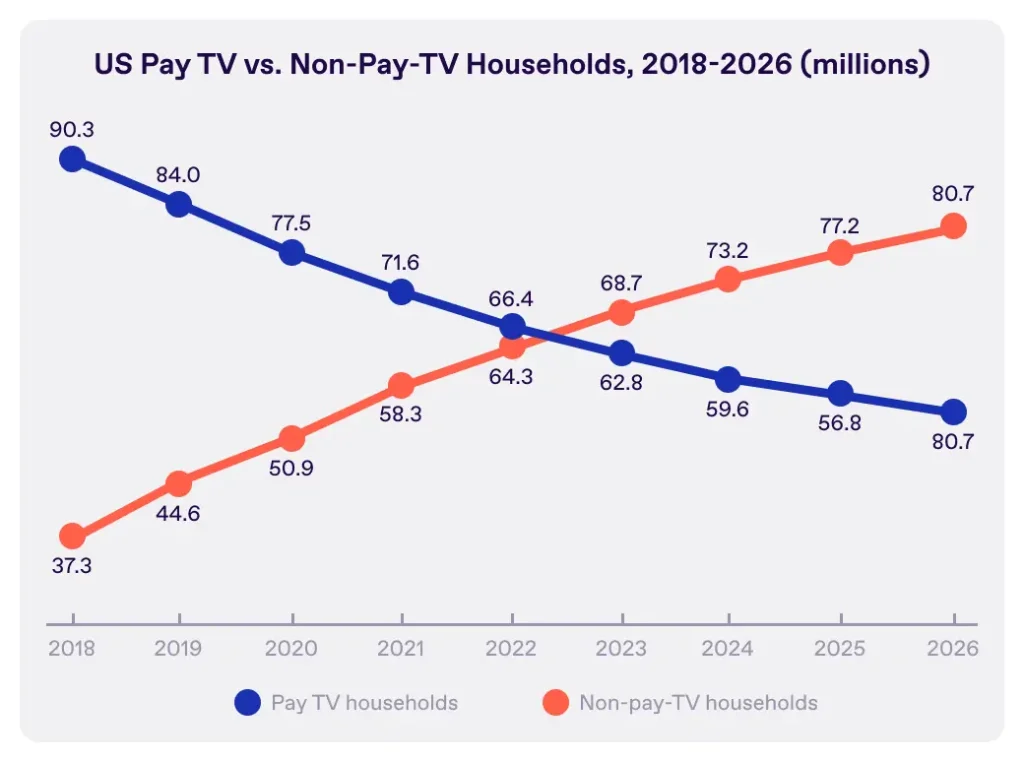vMVPD vs MVPD – There are a lot of acronyms in the linear and streaming TV worlds. What does MVPD mean? What’s the definition of vMVPD? What about VOD, OTT and CTV?
It’s a lot of letters with a lot of similar meanings.
Let’s take a stab at simplifying it all a bit — from an advertiser’s perspective.
What is an MVPD?
MVPD stands for multichannel video programming distributor.
At its simplest, an MVPD delivers traditional, live TV to its subscribers through cable, satellite or fiber connections. Viewers pay the MVPD for access to a variety of TV channels and content. Think of it like a buffet of TV programming options that you can choose from, for a monthly fee. Some MVPD providers also offer video-on-demand options.
Is Comcast an MVPD? What about Spectrum or Cox? Here are some examples of MVPD providers you might be familiar with:
- Comcast Xfinity
- Charter Spectrum
- DirecTV (owned by AT&T)
- Dish Network
- Verizon Fios
- Cox Communications
- Altice USA (including Optimum and Suddenlink)
How does an MVPD work?
An MVPD acts as an intermediary between the TV networks and the viewer, providing access to a wide variety of TV content.
The MVPD works by receiving TV programming from various networks and distributing it to their subscribers — for a fee. They negotiate contracts with these networks to obtain the rights to broadcast their content. Then they package the content into different channel bundles for customers to choose from.
Once a customer signs up for service, the MVPD delivers the TV programming to the customer’s home — typically through a physical cable or satellite connection, depending on the service provider. Notably, because MVPDs are delivered via cable or satellite, they tend to be tied to certain geographic boundaries.

What is a vMVPD
vMVPD stands for virtual multichannel video programming distributor. A vMVPD delivers both live TV programming and on-demand video to viewers via the Internet.
vMVPD providers generally fall into one of two categories: streaming services that have added a live TV option; or MVPD providers that have added an on-demand or streaming service.
You’re probably familiar with the following examples of vMVPD providers:
- YouTube TV
- Hulu + Live TV
- Sling TV
- FuboTV
- Philo
- Xfinity On Demand, Xfinity Stream
- Spectrum On Demand
- DirecTV Stream
Is Netflix a vMVPD? How about Amazon Prime Video or Disney+? You might think so, but Netflix, etc. are actually examples of SVODs (more on that in a moment).
How does a vMVPD work?
A vMVPD negotiates with content providers to obtain rights to distribute their programming. Then they make that content available through an app or web-based platform — for a monthly fee.
These fees can vary depending on the specific vMVPD and the package of channels that the subscriber chooses. Viewers can access vMVPD apps on multiple devices, such as smartphones, tablets, computers, or connected TVs. They have to log into the app or website with account credentials, then they can select the channels and content they want to watch — live TV or on-demand video.
The vMVPD streams the content over the internet to the device, allowing viewers to watch it in real-time or save it for later.
And what about VOD (video on demand)?
We mentioned that Netflix, Amazon and Disney+ are NOT considered vMVPDs — these streaming services are actually considered SVOD (subscription video on demand) providers.
So, what is VOD? VOD stands for video on demand.
VOD providers offer a library of on-demand content that users can watch at their convenience. This means users can choose from movies, TV shows, and other video content to watch whenever they want (rather than having to wait for a scheduled broadcast). VOD providers may also offer original content that is produced exclusively for their service.
The primary difference between a vMVPD and a VOD provider is that the former provides access to live TV programming — the latter does not.
VODs come in a few varieties:
- SVOD: A recurring fee model for access to a library subscription content (e.g. Netflix, Disney+)
- TVOD: A pay-per-view video distribution model (e.g. iTunes, Amazon Prime Video)
- AVOD: Provides an ad-supported distribution model (e.g. Hulu with ads)
- PVOD: Paid access to premium content with a short duration (e.g. new movie releases)
Before you drown in alphabet soup, let’s sum up these video provider acronyms in a digestible chart.

Quick caveat on all the acronyms: the lines are blurring.
As streaming continues to earn viewers, many linear TV providers have begun to offer streaming and/or on-demand options. Comcast Xfinity, for example, now offers Xfinity on Demand and Xfinity Stream, and DirecTV now offers a DirecTV stream. These new offerings fall into the vMVPD and VOD categories.
On the flip side, some companies that launched as VOD services have started offering live TV options more akin to linear. For example, subscribers can now catch a variety of live programming on YouTube TV and Hulu + Live TV. And Apple TV now offers live sports like Major League Baseball (MLB) and Major League Soccer (MLS).
MVPD vs. vMVPD
Ultimately, the choice between advertising with an MVPD or a vMVPD will depend on the advertiser’s specific goals, target audience, and budget.
In general, you can expect your ads to have wide reach to an established audience through an MVPD. On an MVPD, ad placements tend to air at one time to many households. In contrast, vMVPDs tend to air targeted spots to individual households. Each of these methods has its pros and cons for advertisers.
In fact, eMarketer predicts non-pay TV households (which include cord-cutters and cord-nevers) will exceed pay TV households in 2023.

Finally, it’s still difficult to accurately measure ad performance via an MVPD. These providers also offer access to data and insights MVPDs can’t offer, which means better targeting and more accurate measurement. MVPD Graph Results
Key takeaways for TV advertisers
vMVPDs are quickly becoming popular with consumers and advertisers who are looking for alternatives to traditional cable and satellite providers.

But MVPDs are working to keep pace with new digital, on-demand TV offerings.
At the end of the day, the most effective approach is often to work with a TV advertising platform that can deliver ad content across both distribution models, finding the right audiences regardless of channel, device, or connection type.
Not ready to jump in quite yet? Check these pieces out first:
- CTV Advertising—What It Is and How It Works
- What is OTT Advertising? A Beginner’s Guide to Over the Top
- Your Guide to OTT Data—How to Target and Optimize Campaigns
Discover more from Rathergood
Subscribe to get the latest posts sent to your email.

